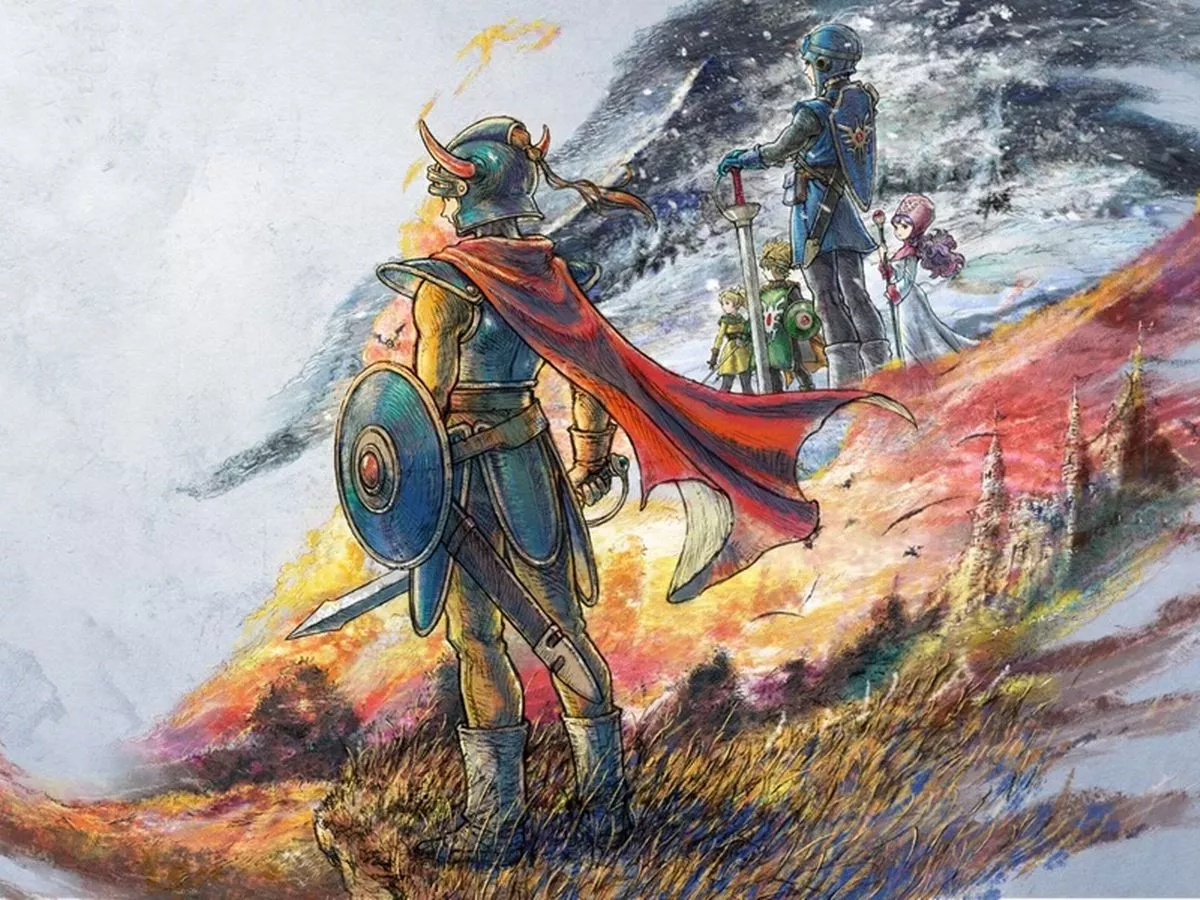Copyright mirror

Dragon Quest 1 and 2 HD-2D Remake does a great job completing the Erdrick trilogy, bringing the first two games' events in line with last year's also excellent Dragon Quest 3 HD-2D Remake. The rivalry between Final Fantasy and Dragon Quest was legendary back in the day. In recent years, however, it’s the latter that’s been most determined to give us interesting ways to replay the original entries in its series. A good thing, too, since the wait for Dragon Quest 12 isn’t getting any shorter, one imagines. And while Dragon Quest 7 Reimagined looks stellar, Square Enix ’s HD-2D treatment feels like the perfect solution, giving players an undeniably beautiful (yet still retro) way to experience the classic JRPGs that got us where we are today. This was the case for last year’s vigorously nostalgic remake of Dragon Quest 3, and it’s much the same again now for Dragon Quest 1 and 2 HD-2D Remake. Only this time in the form of a neatly presented duology. As someone who isn’t yet bored of this aesthetic, the concept of remaking games in a visual style strangely familiar yet not as it was originally fascinates me. In this respect, Dragon Quest 1 and 2 HD-2D Remake unequivocally charms. It’s a retooling that presents its locations, battles, and characters as if these games were released for 16-bit consoles and completes the franchise’s so-called ‘Erdrick trilogy’ using the same revitalised graphics, quality-of-life improvements, and top-tier presentation. Both games have been paid excellent tribute and respect as a result, even if the overall effect is less surprising this time around and some persistent JRPG niggles remain. Whether you’re jumping into these games for the first or umpteenth time, Dragon Quest 1 and 2 HD-2D Remake instantly makes a great first impression. Though heavily pulling from the same principles and general design approach as Dragon Quest 3 HD-2D Remake, the land of Alefgard feels similarly expanded and full of life. Both games cast you as a descendant of a legendary hero, Erdrick, following in their footsteps by saving the world from whatever new evil threat has since chosen to present itself. Speaking honestly, there’s nothing all that narratively surprising or shocking here compared to the JRPG stories of today (particularly in the first game’s case). That said, the HD-2D art style does a lot of heavy lifting to give these otherwise familiar themes of betrayal, heroism, and determination added gravitas. In the case of the original Dragon Quest, the lack of a party system still gives it a distinct flavour compared to the countless entries that would come after. This both simplifies and complicates turn-based battles since you can’t rely on someone else to, say, heal or come to your aid. Instead, the onus is on you – and you alone – to lean into the best possible strategy to whatever battle you come across, deploying spells, special abilities, and regular attacks as necessary. So intrinsic to the genre’s DNA is the concept of a party these days, Dragon Quest 1 is an interesting relic to revisit. It’s rather unique to go it alone on such a sprawling adventure – and that’s despite battles no longer just purely being 1v1 in this remake. Dragon Quest 2, by comparison, is a lot grander in scale – both in its narrative ideas and just generally what’s asked of you. Set roughly 100 years following the first game’s events, you play as a quartet of Erdrick’s scions who must work together to stop a High Priest with ill intent, Hargon, who aims to wreak havoc over Alefgard following a harrowing opening attack on Moonbrooke Castle. The said sequence is just one example of how much impact and added dynamism the HD-2D art style brings to an event that previously left a lot to the imagination in the original. Playing through it here though, nearly 40 years later, as part of this collection, watching buildings get bombarded and catch alight seriously establishes the stakes for the ensuing 30+ hour adventure. So far, so expected, then, particularly if you played the Dragon Quest 3 HD-2D Remake last year. Quality-of-life improvements such as the ability to more easily fast travel, a map marker for your next objective, and multiple difficulty options all make for a much smoother and more user-friendly experience compared to past versions. There are a handful of totally new tweaks exclusive to Dragon Quest 1 and 2 HD-2D Remake, though. The most obvious is the addition of a new explorable part of the overworld and a new party member in the second game. Both further enhance the scope of Alefgard in the direct sequel in ways mostly unobtrusive. The Princess of Cannock now works alongside the three other Dragon Quest 2 party members as a playable character for the first time. She brings an all-new pizzazz to battles using her combination of physical and magic attacks that works to offset the more grounded nature of the main protagonist. Exploring the Ocean Floor, meanwhile, does well to shake up the potential monotony that might otherwise be at risk of setting in after exploring so much grassland, underground, and desert when playing both remakes back-to-back in close succession. The Ocean Floor doesn’t just look visually distinct either. In fact, the locale brings with it more creative variations of familiar enemies that worked to make me think just that bit harder during traditional bouts. While the changes made to Dragon Quest 1 aren’t quite as extensive, there’s still plenty here that helps present it in a new light. Dragon Quest 3’s Robin ‘Ood, for instance, is a newly added boss battle that offers additional context to his main appearance in Alefgard later on, while fairies (and indeed their accompanying village) now play an active role in pushing the main character’s story forward. Altogether, it would have been easy for Square Enix to give Dragon Quest 1 and 2 the third game’s remake treatment and be done with it. Subtle story, character, and location additions, however, work to better complement the existing foundation of both games, and only demonstrate the high regard the publisher holds them in. Obviously, while exceptional and upgraded remakes for the most part, there are still some aspects that left me wanting. While the multiple difficulties from Dragon Quest 3 HD-2D Remake return, for instance, there are still some portions of both games where the pacing seriously suffers either due to the relentlessness of random encounters or the sheer amount of grinding I had to do just to keep my party fighting fit – and this is on the standard difficulty. Some bosses wiped the floor with me all too easily otherwise. Then there’s the fact that not every dungeon is created equal, with more than a few requiring a bit too much backtracking or windy exploration in order to be enjoyed fully. Traversing them is made even more of a hindrance due to the overwhelming number of enemies that can spawn, which only results in bouts that are more annoying than they are challenging. This is especially the case when slimes or chimaera seem intent on calling out for endless amounts of backup, causing my party’s resources to unnecessarily drain before a big confrontation. Simply put, while a lot of mechanics have been modernised, battles still have a tendency to be quite punishing in the classic sense. Overall, Dragon Quest 1 and 2 HD-2D Remake is yet another win in Square Enix’s recent run of HD-2D projects. Although the same degree of visual overhaul as last year’s remake, both games have been expanded mostly for the better, with new scenes, characters, and areas that help further tie them into the events of Dragon Quest 3, resulting in a newfound cohesiveness to Dragon Quest’s Erdrick trilogy. Although battles are still somewhat grindy and the high random encounter rate can eventually take its toll, there’s no denying that this is the best way to experience the franchise’s first two games. If you’re sick of merely hearing about how great and influential this JRPG trilogy is and want to find out for yourself, Dragon Quest 1 and 2 HD-2D Remake is the perfect way to do so. Rating: 4/5



